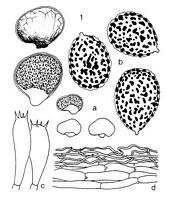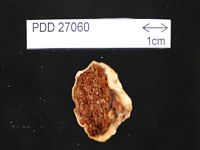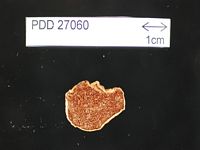|
 Cortinarius nivalis Cortinarius nivalis
SynonymsThaxterogaster nivalis
BiostatusPresent in region - Indigenous. Endemic
Images (click to enlarge)
Caption: Thaxterogaster nivale Hk. sp.n. (type): a. fruitingbodies,
b. spores.
c.
basidia. d. cuticle. | 
Caption: Dried type specimen
Owner: Herb PDD | 
Caption: Dried type specimen
Owner: Herb PDD |
Article: Horak, E. (1973). Fungi Agaricini Novazelandiae I-V. Beihefte zur Nova Hedwigia 43: 200 p.
Description: Gastrocarp
15-35 x 10-40 mm, subglobose to ovoid or irregularly tuberiform, peridium white,
unchanging, glutinous, smooth when dry and occasionally covered with pentagon-like
cracks, about 2 mm thick, not exposing gleba but easily peeling off. Gleba when
young grey-lilac becoming ferruginous or chocolate brown, loculate with irregular
chambers (up to 4 mm diam.), radially arranged, not gelatinised. Columella absent
or penetrating only with few branches into the gleba. Stipe always present but
not well developed, resembling a subgleba in the Lycoperdaceae, mostly
button-like at the base of the gastrocarp, white, glutinous, smooth, lower portion
of peridium connected with apex of the stipe, without rhizoids. Context whitish.
Taste mild. Odor aromatic or intensely acidulous (especially at an over-mature
stage). Chemical reactions on peridium: KOH - negative.
Spores
16-20(-22) x 13-15 µm, ovoid or ellipsoid-oblong, ± axially symmetric, with
prominent apiculus, ferruginous, densely covered with coarse isolated warts,
perisporium well developed, without suprahilar depression or germ pore. Basidia
40-48 x 14-20 µm, clavate, 4-spored. Cystidia none. Cuticle a cutis of intensely
woven gelatinous hyphae (2-4 µm diam.), membrane thin-walled, hyaline, without
pigment. Subcutis consisting of cylindrical hyphae, 8-14 µm diam., clamp connections
present.
Habitat: On
ground amongst mosses and litter under Nothofagus fusca, N. menziesii, N.
cliffortioides and Leptospermum spp.: New Zealand.
Notes: This
species is well characterised by its white colour, the absence of a columella
and the large, coarsely warted spores. In New Zealand Th. nivale Hk.
could be mistaken for Th. anisodorum Hk. or even Th. luteolum
Hk. but the microscopic characters of these taxa are distinctly different. The
south American species Th. brevisporum Singer however, shows a
close relationship to Th. nivale Hk., but differs in shape and size of
the spores, a different kind of ornamentation and other characters of minor
importance.
|